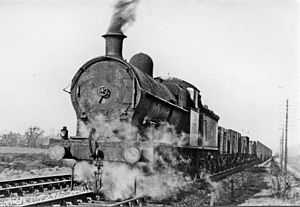LNWR Class G1
| LNWR Class G1 | |
|---|---|
|
Ex-LMS No. 9171 - still unrenumbered in 1951, built as a G1 in May 1912 and withdrawn not long after this photograph in February 1952 | |
| Type and origin | |
| Power type | Steam |
| Designer | Charles Bowen Cooke |
| Builder | Crewe Works |
| Build date | 1901-1904 |
| Total produced |
New builds, 171 Rebuilds, 278 Total, 449 |
| Rebuilder | Crewe Works |
| Specifications | |
| Configuration | 0-8-0 |
| Gauge | 4 ft 8 1⁄2 in (1,435 mm) |
| Driver diameter | 4 ft 5 1⁄2 in (1.359 m) |
| Locomotive weight | 60 long tons 15 cwt (136,100 lb or 61.7 t) |
| Fuel type | coal |
| Boiler pressure | 160 psi (1.10 MPa) |
| Cylinders | 2 inside |
| Cylinder size | 20½" x 24" |
| Performance figures | |
| Tractive effort | 25,640 lbf (114.1 kN) |
| Career | |
| Operator(s) | LNWR » LMS » BR |
| Power class | BR, 6F |
The London and North Western Railway (LNWR) Class G1 was a class of 0-8-0 steam locomotives. It was a superheated version of the LNWR Class G with 8 inch piston valves.[1] The prototype was rebuilt in 1912 from a member of Class G and a further 170 new locomotives were built between 1912 and 1918. In addition, 278 older locomotives were rebuilt to the G1 specification between 1917 and 1934.
Numbering
Numbering is somewhat complicated. The LNWR used a numbering system based on the lowest available number, with the result that the numbers were scattered through the stock book. The London, Midland and Scottish Railway (LMS) renumbered the engines into a more logical series. However, they also then continued to rebuild engines, which retained the numbers originally assigned by the LMS. British Railways (BR) inherited 98 locomotives in 1948 and numbered them in the range 48892-49384. The number series is not continuous because some numbers in the same range were given to G2A Class locomotives.[2]
Construction and rebuilding list
| Source | Dates (re)built | Total (re)built | (Re)built by LNWR | LNWR No(s) | Rebuilt by LMS | LMS No(s) | Notes |
|---|---|---|---|---|---|---|---|
| Prototype Class G | 1912 | 1 | 1 | 2653 | 0 | 9154 | |
| New construction | 1912–1918 | 170 | 170 | ... | 0 | 9155-9334 | |
| Class B | 1917–1927 | 91 | 46 | ? | 45 | ? | |
| Class E | 1917–1924 | 18 | 12 | ... | 6 | ... | |
| Class F | 1921–1924 | 10 | 6 | 1036, 1038, 2570, 2114, 2573, 1369 | 4 | initially: 9349/65/7/72/3/86. | |
| Class D | 1925–1934 | 63 | 0 | n/a | 63 | 9002-64 | |
| Class C | 1925–1927 | 5 | 0 | n/a | 5 | 8953/4/62/4/6 | |
| Class G | ? | 91 | 0 | n/a | 91 | 9077-9144 | |
| Total: | 1912-1934 | 449 | 235 | see above | 214 | see above |
Some were rebuilt back from Class G2a to Class G1 as they passed through heavy overhaul and received lower pressure boilers.
References
- ↑ LNWR Society. "Goods Engines of LNWR - ‘G1’ Class". Lnwrs.org.uk. Retrieved 2012-04-09.
- ↑ Ian Allan ABC of British Railways Locomotives, 1948 edition, part 3, pp 39-40
Further reading
- Bob Essery & David Jenkinson An Illustrated Review of LMS Locomotives Vol. 2 Absorbed Pre-Group Classes Western and Central Divisions
- Edward Talbot, The London & North Western Railway Eight-Coupled Goods Engines
- Willie Yeadon, Yeadon's Compendium of LNWR Locomotives Vol 2 Goods Tender Engines
| ||||||||||||||||||||||||||||||||||||||||||||||||||
